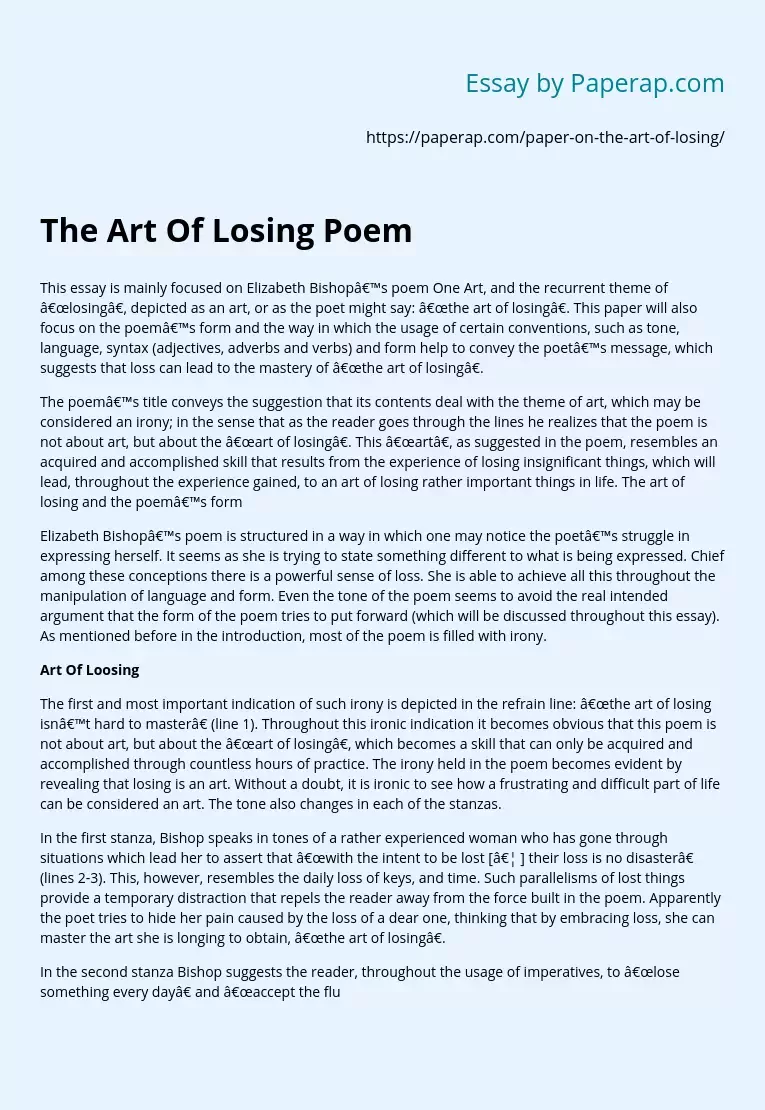This essay is mainly focused on Elizabeth Bishop’s poem One Art, and the recurrent theme of “losing”, depicted as an art, or as the poet might say: “the art of losing”.
This paper will also focus on the poem’s form and the way in which the usage of certain conventions, such as tone, language, syntax (adjectives, adverbs and verbs) and form help to convey the poet’s message, which suggests that loss can lead to the mastery of “the art of losing”.
The poem’s title conveys the suggestion that its contents deal with the theme of art, which may be considered an irony; in the sense that as the reader goes through the lines he realizes that the poem is not about art, but about the “art of losing”. This “art”, as suggested in the poem, resembles an acquired and accomplished skill that results from the experience of losing insignificant things, which will lead, throughout the experience gained, to an art of losing rather important things in life.
The art of losing and the poem’s form
Elizabeth Bishop’s poem is structured in a way in which one may notice the poet’s struggle in expressing herself. It seems as she is trying to state something different to what is being expressed. Chief among these conceptions there is a powerful sense of loss. She is able to achieve all this throughout the manipulation of language and form. Even the tone of the poem seems to avoid the real intended argument that the form of the poem tries to put forward (which will be discussed throughout this essay).
As mentioned before in the introduction, most of the poem is filled with irony.
Art Of Loosing
The first and most important indication of such irony is depicted in the refrain line: “the art of losing isn’t hard to master” (line 1). Throughout this ironic indication it becomes obvious that this poem is not about art, but about the “art of losing”, which becomes a skill that can only be acquired and accomplished through countless hours of practice. The irony held in the poem becomes evident by revealing that losing is an art. Without a doubt, it is ironic to see how a frustrating and difficult part of life can be considered an art. The tone also changes in each of the stanzas.
In the first stanza, Bishop speaks in tones of a rather experienced woman who has gone through situations which lead her to assert that “with the intent to be lost [… ] their loss is no disaster” (lines 2-3). This, however, resembles the daily loss of keys, and time. Such parallelisms of lost things provide a temporary distraction that repels the reader away from the force built in the poem. Apparently the poet tries to hide her pain caused by the loss of a dear one, thinking that by embracing loss, she can master the art she is longing to obtain, “the art of losing”.
In the second stanza Bishop suggests the reader, throughout the usage of imperatives, to “lose something every day” and “accept the fluster” (line 4). Through the usage of imperatives and by sounding dominant, Bishop tells the reader that “the art of losing isn’t hard to master”. The only thing that is left is to “accept the fluster of lost door keys, the hour badly spent”(lines 4-5). Up to this point it seems as if the poet is trying to provide the reader with a guide devoted to the mastering of “art losing”.
Suggesting that by following her simple advices, the reader can, too, achieve such art. It seems as if Bishop is trying to put forward the philosophical reflection of the first stanza throughout imperatives and a second person speaker. The third stanza intensifies the intention of the previous stanza in being developed as a command with a simple shift to “then”(line 7). Bishop puts forward an increasingly dynamic agenda devoted to loss, she commands the reader to “practice losing farther, losing faster”(line 7), but now she is not losing simple things.
Bishop goes from losing simple things to losing “places, and names, and where it was you meant to travel” (line 8). It appears as if she is simply shifting the tone to a confessional one, since it has become evident, up to here, that Bishop is the one who speaks, which will become evident in the following stanza, she addresses the reader and shares her own experiences. Throughout the poem, the changes in tone and speaker bestow the poet’s efforts to cover up her true feelings.
She goes from denying the importance of losing significant, but rather essential things, to the loss of personal belongings. The usage of colloquial language intensifies the poems emotional power that has been hidden until now. The rhyme scheme Bishop employs and the usage of the “villanelle” appeal to put forward the intention and message of the poem, apart from lessening the seriousness of Bishop’s true feelings. The poem in the fourth and fifth stanzas gains intensity, since the poet refers to the loss of properties, and places.
The Art Of Losing Poem. (2019, Dec 05). Retrieved from https://paperap.com/paper-on-the-art-of-losing/

